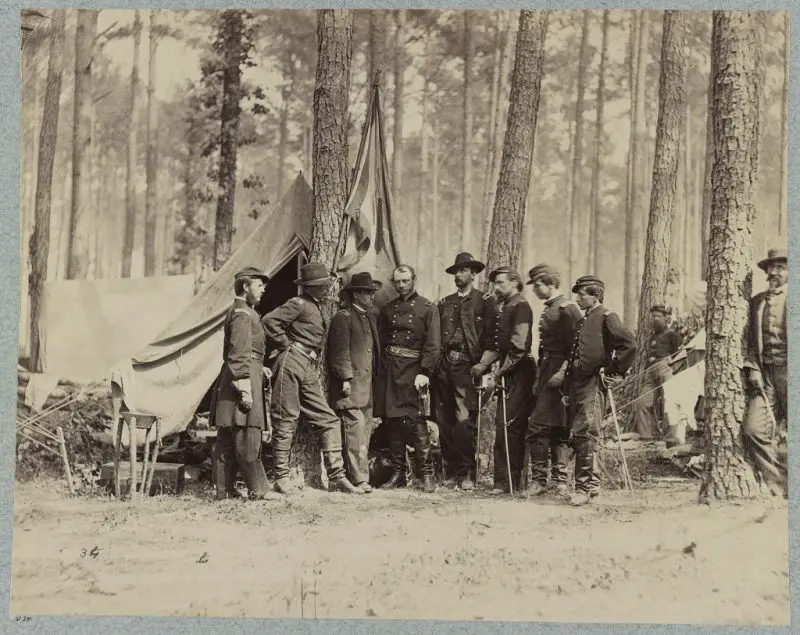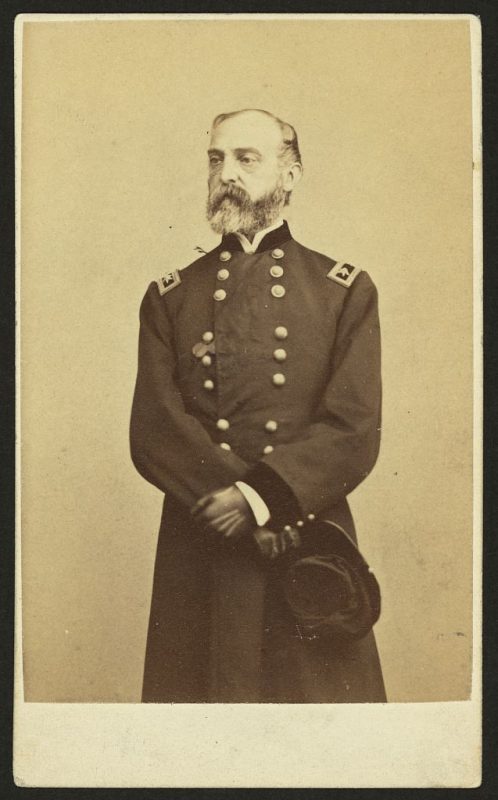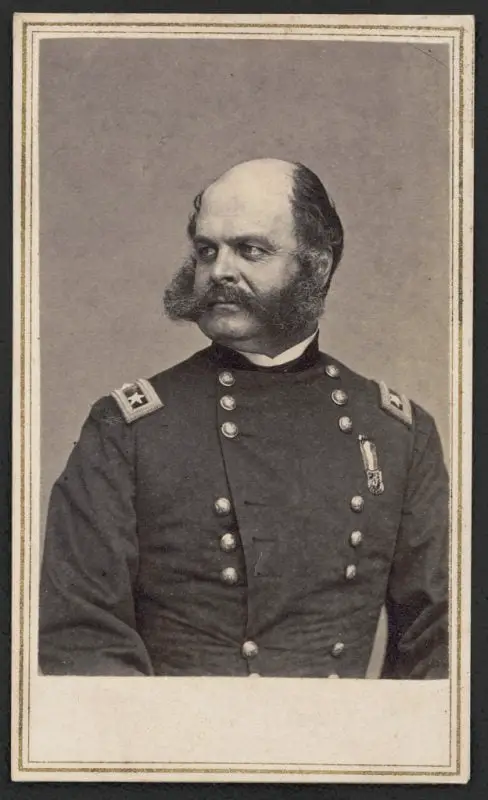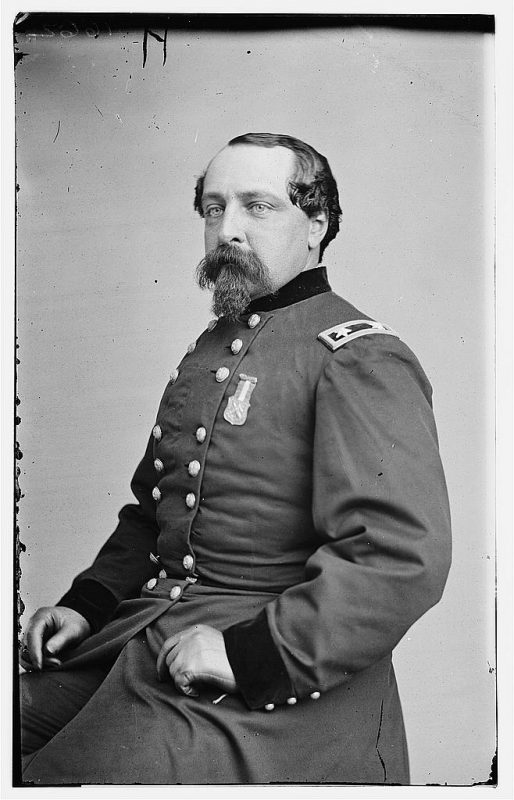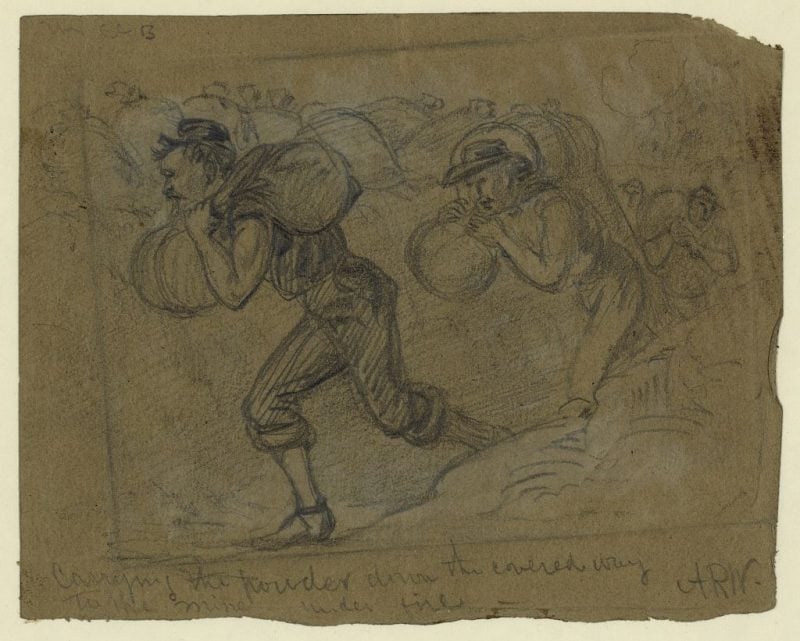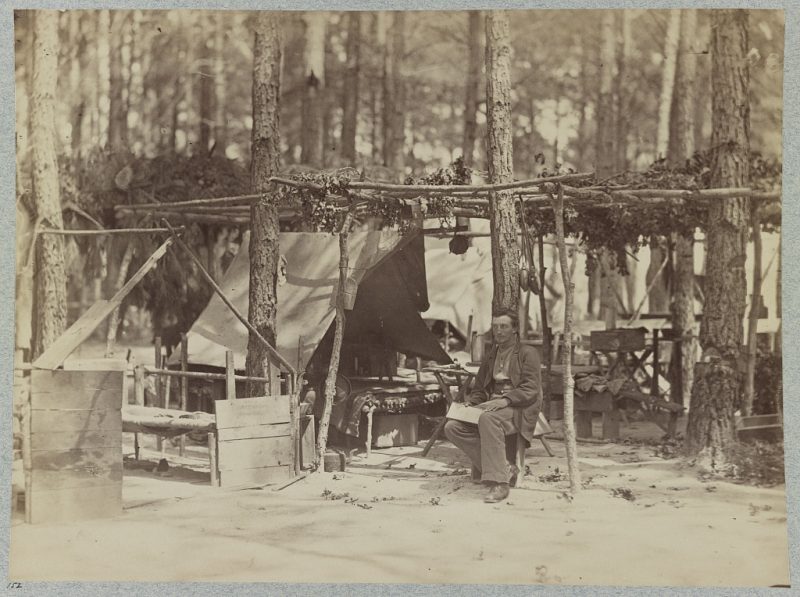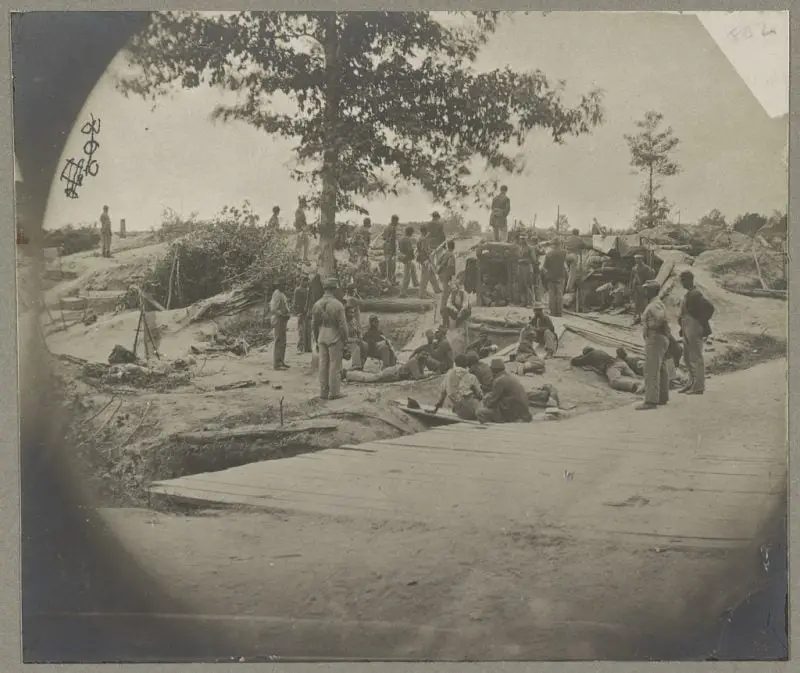The battle of the Crater took place on July 30, 1864 outside the city of Petersburg Virginia. The rebel held town of Petersburg was on the road to the Confederate capital of Richmond Virginia, it was also a major Confederate railroad depot for supplies that went into the city of Richmond. It was essential for the Union to capture Petersburg, it was just as critical for the Confederates to keep it.
Why Did the Battle of the Crater Happen
The Siege of Petersburg began in the middle of June 1864 and quickly turned into a stalemate. The Union Army made several assaults against Petersburg but could not break through the heavily entrenched Confederates. It was believed that a large explosion would open a breach in the Confederate line.
The Union was desperate to break the Confederate line and capture the town. In late June Brigadier General Robert B. Potter commander of the Second Division of the Ninth Corps and Lieutenant Colonel Henry Pleasants commander of the 48th Pennsylvania Infantry regiment, which consisted mainly of coal miners from Schuylkill County Pennsylvania presented an innovative idea to the commander of the Ninth Corps Major General Ambrose Burnside.
They believed a Confederate fort directly across from their position could be destroyed. Pleasants and his men wanted to dig a tunnel under the Confederate line. The tunnel would then be filled with gunpowder and detonated under the Confederate fort.
This explosion would be catastrophic to the Confederate defenders killing many of them and opening a huge breach in their line. The stunned defenders would be slow to recover from such a huge explosion.
This would present a great opportunity for Union troops to immediately attack the gap in the Confederate line and overwhelm the defenders. The Union Army would then capture the town and be free to move on and capture Richmond and win the war.
General Burnside approved of the idea and ordered construction of the tunnel to start immediately, construction began on June 25th. If nothing else General Burnside reasoned, it would at least give his men something to do. After construction had begun General Burnside presented the plan to his commanding officer Major General George Gordon Meade.
The commander of the Army of the Potomac General Ulysses S Grant was eager to make an attack against Petersburg in order to break through their line. General Meade therefore authorized the continuance of the operation, sanctioned it and entrusted that the work would at some point result in forming an important part in the operations around Petersburg.
At first Meade did not have much confidence that the plan would actually work. Meade did not like the location of the mine believing it was in a bad position and that the Confederate line was too strong and the attack would fail.
After taking a better look at the Confederate defenses in the area and realizing that they were weaker than he initially thought, Meade decided that the assault had a good chance of being successful if carried out properly.
Battle of the Crater Initial Plan of Attack
General Burnside was the commander of the Ninth Corps in the Army of the Potomac. He had three white divisions and one black division under his command.
- First Division Commanded by Brigadier General James H. Ledlie
- Second Divison Commanded by Brigadier General Robert B. Potter
- Third Divison commanded by Brigadier General Orlando B. Willcox
- Fourth Divison commanded by Brigadier General Edward Ferrero
Burnside’s plan called for the African American Fourth Division under the command of Brigadier General Edward Ferrero to make the initial assault. The black division was chosen for this task because they were fresh and had not seen much combat since arriving near Petersburg in mid June.
Burnside’s three white divisions which consisted of 9,023 men had been in the trenches on the front line for almost a month since arriving near Petersburg on June 18th. They sustained 1,150 casualties from rifle fire and artillery shelling, were exhausted and deemed unfit for such an important operation. They were more interested in staying under cover and out of sight, and were in no condition to assault the Confederate line.
The plan was for the mine to be detonated at 3:30 am on July 30th. After the explosion, the black soldiers would immediately dash to the Confederate gap that had opened up. The advance would be covered by Union artillery that would fire on the Confederate positions as they made their run toward the Confederate line.
The black troops were to run around the sides of the crater and pass through the Confederate line where they would capture a crest about 500 yards away called Cemetery Hill which overlooks the town of Petersburg. On the crest they would form a defensive line and wait for reinforcements.
General Burnside’s white divisions would support the black troops and follow behind them during the assault. The black troops would also be supported on their right by troops under General Edward Ord and on the left by troops under General Warren.
At that point more divisions would flood into the area forcing the Confederates to retreat from Petersburg. The Union army then hoped to chase the Confederates over the bridges on the Appomattox River and Swift Run and continue on to capture Richmond.
The assault would have to take place very rapidly, if there was any delay the Confederates would recover from the initial shock of the explosion and be able to rush troops into the breach, reform their line and counterattack.
Battle of the Crater Revised Plan of Attack
General Meade opposed Burnside’s plan, he did not want black troops making the initial assault. He believed the first wave of attackers would suffer heavy casualties and did not want to be accused of using black troops in such a way. He also said he wanted Burnside’s best troops with the most combat experience to make the initial assault.
General Burnside was very upset with this decision, in order to appease Burnside, General Meade agreed to ask General Grant’s opinion on the matter.
General Grant after considering both arguments agreed with General Meade that the black soldiers should not lead the assault. The matter was settled and General Meade ordered Burnside to select a white division to lead the assault while the black troops would be in a supporting role.
With no other choice General Burnside had to decide which one of his three white divisions would lead the attack during the battle of the crater. The decision to force Burnside to choose a white division came on the afternoon of July 29th only one day before the attack was to take place.
The troops in the three white divisions had received no training or information about the assault, this short notice only gave these officers and men about 12 hours to prepare for the attack. The black division on the other hand had weeks of training and drills in preparation for the attack.
Burnside could not decide which division would lead the attack. So he decided that “It will be fair to cast lots”. The three divisional commanders cast lots and General Ledlie of the First Division drew the lot to make the assault. Of the three generals he was the least qualified his troops were also located in the worst position to make the attack. Ledlie’s troops did however see the least amount of combat during the Petersburg campaign so they were physically in better shape to make the assault.
Battle of the Crater July 30th 1864
After several weeks of work, the tunnel was finally completed on July 23, 1864. The mine was T shaped. The main gallery (shaft) was 510 feet long extending from the Union line to the Confederate line. The mine also had two side galleries the left gallery was 37 feet long and the right gallery was 38 feet long. The side galleries ran along the Confederate line at a slight angle.
On July 27th the side galleries were filled with 8,000 pounds of gunpowder, It took six hours to fill the mine with gunpowder. Ten feet into the entrances of both side galleries were packed with dirt and thirty four feet from the side galleries into the main gallery were also packed with dirt.
At 2:00 am on July 30th General Burnside left his permanent headquarters and moved closer to the assault position near an artillery battery at the center of the Ninth Corps line. Here he would be able to oversee and command the assault.
It was an extremely dark night, it was so dark that General Grant asked General Burnside if he wanted to delay the mine detonation until it became lighter.
Burnside declined the offer and said the mine would be detonated at the scheduled time of 3:30 am.
At 3:30 am Burnside and his officers felt great anxiety and were nervously anticipating the explosion. The minutes began quickly ticking by with no detonation. Burnside assumed it was simply a calculation error and the fuse was taking longer then they originally estimated.
The timing was critical for a successful attack and as the minuets continued to tick by General Meade became concerned and sent an officer to Burnside’s headquarters to know the reason for the delay. Burnside not knowing why it was delayed sent a message to Colonel Pleasants at the mine to find out what was causing the delay.
General Meade becoming more agitated told Burnside that if the mine had failed he was to order his men to attack anyway. This of course was suicidal for Burnside’s men. General Meade was ordering a night attack against heavily entrenched Confederate lines. Burnside delayed ordering this attack so he could find out why the mine had not exploded.
The fuse being used was ninety-eight feet in length running from both side galleries through the main gallery extending outside of the mine. The length of fuse needed was not available so two fuses were spliced together. An officer and a sergeant of the 48th Pennsylvania bravely entered the mine and found that the fuse had failed at the splice.
They quickly spliced it back together and re-lit the fuse. Eleven minutes later at 4:44 am the mine exploded.
The explosion took place under a fort in a salient in the Confederate line where General John Pegram’s battery was located. The blast buried a regiment of Confederates.
How Big Was the Crater at Petersburg
The explosion opened up a large crater in the ground roughly 200 feet long, 50 feet wide and 25 feet deep.
The explosion also had an effect on the Union troops who were making the initial assault. It caused some confusion and anxiety in the line resulting in a delay in the attack. It took roughly five minutes for the men to clear the obstacles in front of their line and leave the trenches. It took another ten minutes before they reached the crater. This fifteen minute delay gave the Confederates time to recover and begin to respond to the Union advance.
What Happened to the Regiment at the Battle of the Crater
When the First Division reached the crater instead of going around it as ordered they went directly into it and stopped. The mine exploded under a Confederate fort, this left massive amounts of debris in and around the crater making it difficult to navigate, also the Confederate line near the crater was not made up of a single line of trenches, it was a complex maze of trenches, bomb proof shelters, pits and traverses. All of this caused great confusion in the Union ranks.
At first there was little Confederate resistance. If the men in the First Division were drilled, trained and properly led for this assault they could easily have continued on and taken the crest at Cemetery Hill as planned. Instead the First Division sat in the crater for fifteen minutes trying to organize and decide what to do next.
While the Union troops were massed in the crater not sure what to do next Confederate Brigadier General William Mahone quickly organized his division and gathered together any other troops he could find. General Mahone concentrated his troops in a semi-circle around the crater and began firing into it with rifle, artillery and mortar fire.
The First Division was continually ordered to leave the crater and capture Cemetery Hill which was 500 yards away. The men refused to leave the protection of the crater. The commanding officer of the First Division Brigadier General Ledlie was not with his men. He was safe behind the lines in a bomb proof shelter and did virtually nothing during the attack except send a few orders saying they need to advance and take the crest. It has been speculated that General Ledlie was drunk during the battle of the crater and this is why he did nothing.
General Ledlie was not alone in the bunker he was joined by Brigadier General Edward Ferrero commander of the African American Fourth Division who also did very little while his troops were bravely fighting in the crater.
At 5:40 am General Burnside was ordered to push forward with all four of his divisions and capture the crest. The Second and Third Divisions began their assault. They passed through the First Division still in the crater and were able to advance about 200 yards beyond the crater toward the crest. They were driven back by heavy Confederate fire. After some delay the Forth Division, the black troops also made their assault. They too were driven back into the crater along with the three white divisions.
Under increasingly heavy Confederate fire the Union troops now jammed together in the crater did the best they could to defend themselves. The Confederates made several charges at the ruined fort and into the crater and severe hand to hand combat resulted. It soon became evident the attack was a failure and would not succeed.
At 9:25 am Burnside received the order to withdraw his troops from the battle of the crater. He protested the order still believing his troops could take the crest. Of all the officers in charge he was the only one who thought they could still win. He was told by General Meade the decision was final.
At around 11:00 am the order to withdraw was received by the men in the crater. Since these troops were under such heavy fire they would not be withdrawn until it was deemed safe enough to do so. At one point General Burnside suggested building a trench extending from the Union line to the crater in order to allow his troops to withdraw more safely. Burnside also wanted to wait until nightfall to withdraw the men under the cover of darkness.
At around 2:00 pm as the men in the crater were preparing to fall back the Confederates launched an attack against the crater forcing the Union troops to flee in confusion back to their lines.
Most of the Union casualties took place as they were fleeing from the crater. The black troops suffered the most casualties during the battle. Many of them were beaten and killed after they had surrendered to the Confederates. The Confederate losses during the battle of the crater were roughly 1,500 men killed, wounded and missing.
How Long Did the Battle of the Crater Last
The battle of the crater took place on July 30th 1864. The mine exploded at 4:44 am and Union troops retreated at 2:00 pm. The battle lasted roughly 9 hours and 16 minutes.
How Many Union Soldiers Died in the Crater
In total the Ninth Corps lost 3,828 men during the battle of the crater
This number consisted of:
- Killed 29 officers and 348 men
- Wounded 105 officers and 1,556 men
- Missing 87 officers and 1,652 men
Battle of the Crater Court of Inquiry
On August 3, 1864 it was decided that a court of inquiry was to be convened in front of Petersburg on August 5, 1864 to determine the facts and circumstances that led to the unsuccessful assault on the Confederate line during the battle of the crater.
The officers in charge of the operation were called to testify. They were
- Major General George Gordon Meade
- Major General Ambrose Burnside
- Major General Warren
- Major General Sheridan
- Major General Ord
- Brigadier General White
- Brigadier General Hunt
- Brigadier General Mott
- Major Duane
The court was convened and led by
- Major General Winfield Scott Hancock
- Brigadier General Ayres
- Brigadier General Miles
- Colonel Schriver.
After several weeks of investigation and testimony into the failed battle of the crater from the officers in charge. The court concluded that Major General Ambrose Burnside, Brigadier General James H. Ledlie, Brigadier General Edward Ferrero, Colonel Bliss and Brigadier General Orlando B. Willcox were at fault, and were all responsible in one way or another for the failure during the Battle of the Crater.
Several months later General Meade was deemed responsible for the defeat. It was determined that his decision to alter General Burnside’s original plan was the contributing factor that led to the failure of the attack.

